Seasonal variations in gut microbiota and disease course in patients with inflammatory bowel disease
- PMID: 37071621
- PMCID: PMC10112787
- DOI: 10.1371/journal.pone.0283880
Seasonal variations in gut microbiota and disease course in patients with inflammatory bowel disease
Abstract
Background and aim: Environmental factors are associated with onset and course of inflammatory bowel disease (IBD). Our previous study by about 1,100 IBD patients revealed half of the patients experienced seasonal exacerbation of disease. We investigated the seasonality of fecal microbiota composition of IBD patients.
Methods: Fecal samples were consecutively collected in each season from IBD outpatients and healthy controls between November 2015 and April 2019. Participants who were treated with full elemental diet or antibiotics within 6 months or had ostomates were excluded. Bacterial profiles were analyzed by 16S rRNA sequencing, and the changes between the diseases and seasons were compared.
Results: A total of 188 fecal samples were analyzed from 47 participants comprising 19 Crohn's disease (CD) patients, 20 ulcerative colitis (UC) patients, and 8 healthy controls (HC). In CD patients, the phylum Actinobacteria and TM7 were both significantly more abundant in autumn than in spring and winter, but not in UC patients and HC. Moreover, the genera Actinomyces, a member of Actinobacteria, and c_TM7-3;o_;f_;g_ (TM7-3), that of TM7, were significantly more abundant in autumn than in spring, and the abundance of Actinomyces was significantly correlated with that of TM7-3 throughout the year in CD patients, but not in UC patients and HC. CD patients with high abundance of TM7-3 in the autumn required significantly fewer therapeutic intervention than those without seasonal fluctuation.
Conclusions: Oral commensals Actinomyces and its symbiont TM7-3 were correlatively fluctuated in the feces of CD patients by season, which could affect the disease course.
Copyright: © 2023 Tani et al. This is an open access article distributed under the terms of the Creative Commons Attribution License, which permits unrestricted use, distribution, and reproduction in any medium, provided the original author and source are credited.
Conflict of interest statement
The authors have declared that no competing interests exist.
Figures
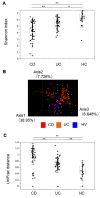

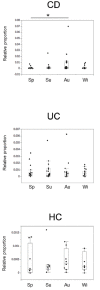
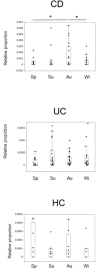
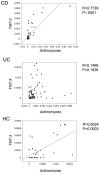
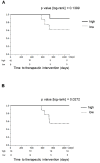
Similar articles
-
Gut microbiota in mucosa and feces of newly diagnosed, treatment-naïve adult inflammatory bowel disease and irritable bowel syndrome patients.Gut Microbes. 2022 Jan-Dec;14(1):2083419. doi: 10.1080/19490976.2022.2083419. Gut Microbes. 2022. PMID: 35695669 Free PMC article.
-
Intestinal TM7 bacterial phylogenies in active inflammatory bowel disease.J Med Microbiol. 2008 Dec;57(Pt 12):1569-1576. doi: 10.1099/jmm.0.47719-0. J Med Microbiol. 2008. PMID: 19018031
-
Intestinal Taxa Abundance and Diversity in Inflammatory Bowel Disease Patients: An Analysis including Covariates and Confounders.Nutrients. 2022 Jan 8;14(2):260. doi: 10.3390/nu14020260. Nutrients. 2022. PMID: 35057440 Free PMC article.
-
Differences in Gut Microbiota in Patients With vs Without Inflammatory Bowel Diseases: A Systematic Review.Gastroenterology. 2020 Mar;158(4):930-946.e1. doi: 10.1053/j.gastro.2019.11.294. Epub 2019 Dec 5. Gastroenterology. 2020. PMID: 31812509
-
Inflammatory bowel disease: between genetics and microbiota.Mol Biol Rep. 2020 Apr;47(4):3053-3063. doi: 10.1007/s11033-020-05318-5. Epub 2020 Feb 21. Mol Biol Rep. 2020. PMID: 32086718 Review.
Cited by
-
Climate Change and Psychiatry: The Correlation between the Mean Monthly Temperature and Admissions to an Acute Inpatient Unit.Int J Environ Res Public Health. 2024 Jun 25;21(7):826. doi: 10.3390/ijerph21070826. Int J Environ Res Public Health. 2024. PMID: 39063403 Free PMC article.
-
Incidence of Inflammatory Bowel Disease in Children.Gastroenterology Res. 2025 Apr;18(2):71-84. doi: 10.14740/gr2007. Epub 2025 Mar 25. Gastroenterology Res. 2025. PMID: 40322194 Free PMC article.
-
Two-Year Study on the Intra-Individual Dynamics of Gut Microbiota and Short-Chain Fatty Acids Profiles in Healthy Adults.Microorganisms. 2024 Aug 20;12(8):1712. doi: 10.3390/microorganisms12081712. Microorganisms. 2024. PMID: 39203554 Free PMC article.
References
-
- Best WR, Becktel JM, Singleton JW, Kern F Jr., Development of a Crohn’s disease activity index. National Cooperative Crohn’s Disease Study. Gastroenterology. 1976;70(3):439–44. - PubMed
Publication types
MeSH terms
Substances
LinkOut - more resources
Full Text Sources
Medical
Miscellaneous

